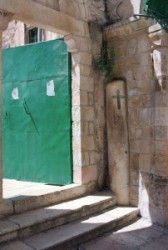GALLERIES
|
COUNTRIES, CULTURES, HISTORY / Israel, Holy Land, Palestina / Christians / The Via Dolorosa, The Way of Sorrow
Legend has it that almost immediately after the crucifixion of Jesus, his followers began to retrace his steps to Calvary. The term âVia Dolorosa- The Way of Sorrow was popularized in the 16th century and its fourteen stations were standardized by the Franciscans during the 19th century. The Way of the Cross, Via Dolorosa or Via Crucis designates a stretch of road between the Antonia fortress and Golgotha, along which Jesus Christ walked bowed under the weight of the Cross. The name dates from the sixteenth century, although the custom of retracing Jesus' steps to Golgotha began in the early centuries of Christianity.
|
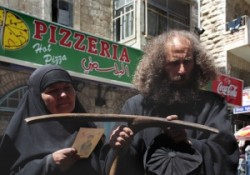
|
The Way of Sorrow-Third Station
|
The Way of Sorrow, Third Station â A small chapel built by Polish Catholic cavalrymen marks the spot where Jesus fell for the first time. The chapel belongs to the Armenian Catholic Patriarchate. |
|
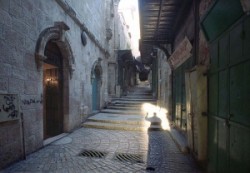
|
The Way of Sorrow- Sixth Station
|
The Way of Sorrow, Sixth Station. Church of St. Veronica. The Armenian Orthodox church here recalls Veronica who wiped the brow of Jesus with her veil. The impressions of His face remained on the veil which has been kept in St. Peterâs since 707. Inside the church is the tomb of St. Veronica.
|
|
|
|
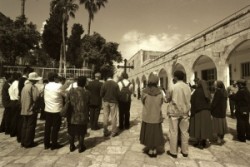
|
The Way of Sorrow- First Station
|
the Chapel of the Flagellation where tradition holds that Jesus was interrogated by Pilate. The Franciscans and Pilgrim's begin their weekly procession through the Stations of the Cross here, on Friday afternoons. This modest chapel was built on the site of a Crusader oratory. Inside are glass panel representing the scourging of Jesus (center), Pilate cleansing his hands of the blood of the innocent (left), and the liberation of Barabas (right).
|
|
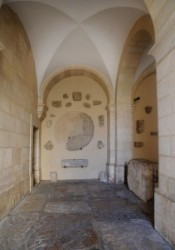
|
The Way of Sorrow- Second station
|
The Way of Sorrow, Second station_Second Station- the Chapel of the Flagellation where tradition holds that Jesus was interrogated by Pilate. The Franciscans begin their weekly procession through the Stations of the Cross here, on Friday afternoons. This modest chapel was built on the site of a Crusader oratory. Inside are glass panel representing the scourging of Jesus (center), Pilate cleansing his hands of the blood of the innocent (left), and the liberation of Barabas (right).
Ecce Homo Arch â this is the second station along the Via Dolorosa. In the 16th century, pilgrims began to refer to the arch as Ecce Homo Arch, referring to Pilateâs declaration as he presented Jesus to the crowd of spectators âBehold the man!-.In reality it is part of a triumphal arch built by Hadrian in 135 A.D. to commemorate his conquest of Jerusalem. The original arch had three parts> the largest, central arch which spans the Via Dolorosa, the left arch which is no longer in existence, and the right arc that can still be seen today inside the Church of the Sisters of Zion.
|
|
|
|




